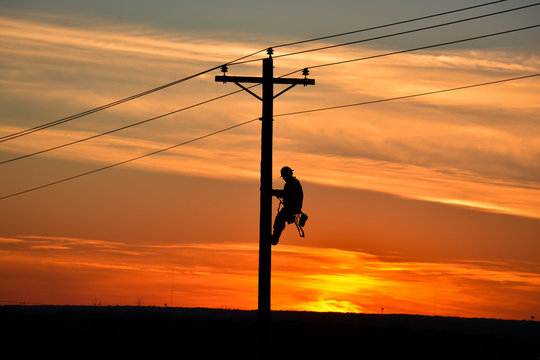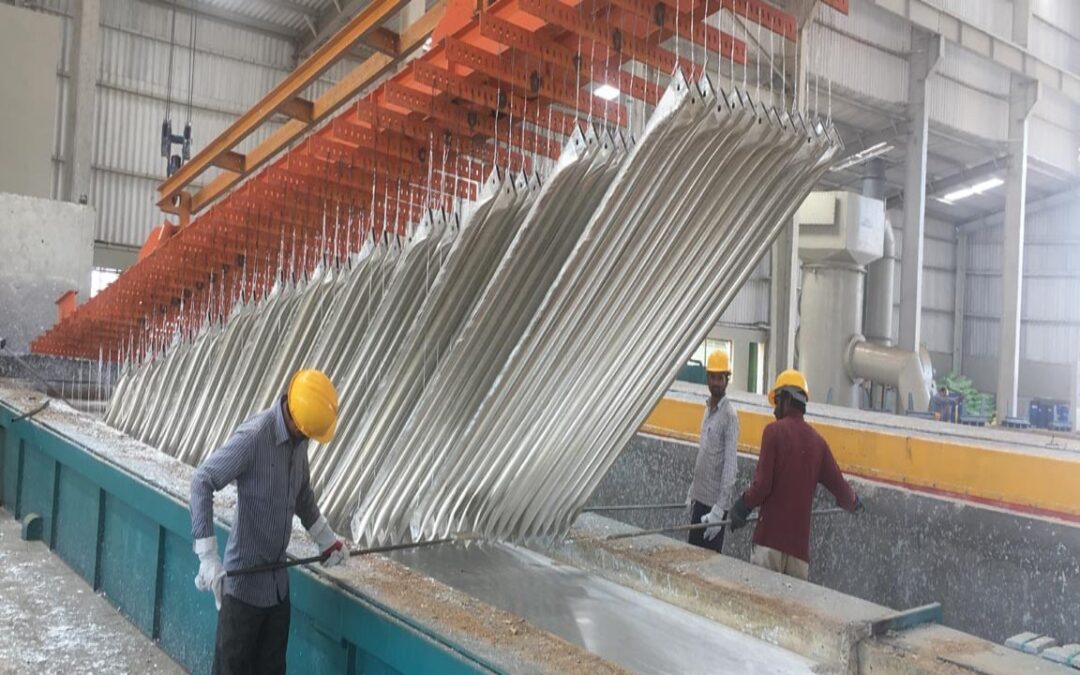Hot-dip galvanizing is a chemical treatment.It is an electrochemical reaction. Cold galvanizing is a physical treatment.It is just brush a layer of zinc on the surface. Then the zinc layer is easy to fall off. Hot-dip galvanizing is often used in construction.
Continuous hot dip galvanizing process: steel → heating → cooling to galvanizing temperature → galvanizing → cooling
TTF Power use hot dip galvanized on the production of power line hardware, such as pole line fittings, line construction accessories and utility fasteners.
History
Hot-dip galvanizing is developed from the older hot-dip galvanizing method. It has a history of 140 years since the application of hot-dip galvanizing to the industry in France in 1836. However, the hot-dip galvanizing industry has developed on a large scale with the rapid development of cold-rolled strip in the past three decades.
Production Process
The production process of hot-dip galvanized sheet mainly includes: original plate preparation → pre-plating treatment → hot-dip plating → post-plating treatment → finished product inspection, etc. According to the custom, the hot-dip galvanizing process is divided into two categories: off-line annealing and in-line annealing according to the different pre-plating treatment methods.
This passage will demostrate them respectively.
Off-line annealing
You should recrystall annealing in a bottom-draw annealing furnace or a bell-type annealing furnace at first. Then put the hot-dip galvanizing line into the hot-rolled or cold-rolled steel sheet. In this way, there is no annealing process in the galvanizing line.
The steel sheet must maintain a clean pure iron active surface free of oxides and other contaminants before hot-dip galvanizing. This method ensures to remove the annealed surface iron oxide scale by pickling at first. Then coat a layer of zinc chloride or a solvent composed of ammonium chloride and zinc chloride for protection. Thus, to prevent the steel plate from being oxidized again.
Wet Hot Dip Galvanized
The solvent on the surface of the steel plate is not dried. Then put it into the zinc solution covered with molten solvent for hot-dip galvanizing.The disadvantages are:
a. Only galvanized in lead-free state. The alloy layer of the coating is very thick and the adhesion is poor.
b. The resulting zinc slag is accumulated at the interface of zinc liquid and lead liquid and cannot be deposited on the bottom of the pot.Thus, the steel plate contaminates the surface by passing through the zinc layer. So, this method has been largely eliminated.
Sheet steel
This method generally uses hot-rolled stacked sheets as raw materials.Firstly,send the annealed steel plate to the pickling workshop. Then, remove the oxygen hot-dip galvanized iron sheet on the surface of the steel plate with sulfuric acid or hydrochloric acid. After pickling, immerse the steel plate in the water tank for galvanizing. This can prevent the steel plate from reoxidizing.
After pickling, washing with water, squeezing, drying, and entering into a zinc pot (the temperature has been kept at 445-465 ℃), hot-dip galvanizing, and then oiling and chromizing. The quality of hot-dip galvanized sheet produced by this method improved than that of wet galvanized products It is only valuable for small-scale production.
Wheeling
The production line includes a series of pretreatment processes such as lye degreasing, hydrochloric acid pickling, water rinsing, solvent coating, and drying. The original plate needs to be annealed in a bell furnace before entering the galvanizing line. Wheeling is complicated, and the production cost is high.
The products produced by this method often have solvent defects. This may affect the corrosion resistance of the coating. In addition, the aluminum in the zinc pot often reacts with the solvent on the surface of the steel plate to form aluminum trichloride and is consumed. The adhesion of the coating is deteriorated. Therefore, although this method has been in existence for nearly 30 years, it has not been developed in the world hot-dip galvanizing industry.

In-line annealing
In this process, coils are supplied directly from the cold or hot rolling workshop as hot-dip galvanized raw sheets. Gas-shielded recrystallization annealing is carried out in the hot-dip galvanizing line.There are five strategics for in-line annealing.
Sendzimir
This method combines the annealing process with the hot-dip galvanizing process. In-line annealing mainly consists of an oxidation furnace and a reduction furnace. The strip steel is directly heated to about 450 degrees by the gas flame in the oxidation furnace. The residual rolling oil on the surface of the strip steel is burned off to purify the surface.
Then, heat the strip steel to 700-800 degrees to complete recrystallization annealing. Control the temperature before entering the zinc pot to be about 480 degrees through the cooling section. Finally, enter the zinc pot for galvanizing without exposure to air. Therefore, the Sendzimir method has high yield and good galvanizing quality. This method has been widely used.
UEC
It is a variant of the Sendzimir process. It is simply replaces the degreasing action of the oxidation furnace with an alkaline electrolytic degreasing tank. The rest of the procedures are basically the same as the Sendzimir method. This method is beneficial for furnace safety and low production costs. The strip steel enters the reduction furnace without preheating. This increases the heat load of the reduction furnace and affects the life of the furnace. Therefore, this method has not been widely used.
Selas
Also known as direct flame heating. The production process of this method is complicated. Especially when the unit is stopped, in order to avoid burning the strip, it is necessary to adopt the method of traversing the furnace away from the strip. There are many problems with this operation. Therefore, this method is rarely used in the hot-dip galvanizing industry.
Sharon
In 1939, the American Sharon Company put into production a new type of hot-dip galvanizing unit, so it is also called Sharon method. The method is to spray hydrogen chloride gas to the strip in the annealing furnace and make the strip reach the recrystallization temperature. Also known as gas pickling.
The use of hydrogen chloride gas pickling can not only remove the oxide skin on the surface of the strip, but also remove the grease on the surface of the strip. Due to the serious corrosion of the equipment, it causes high equipment maintenance and update costs. Therefore, this method is rarely used.
Improved Sendzimir
It is a more superior hot-dip galvanizing process method. It connects the separate oxidation furnaces and reduction furnaces in the Sendzimir process by a passage with a smaller cross-sectional area. In this way, the whole annealing furnace including the preheating furnace, reducing furnace and cooling section constitutes an organic whole. This method has many advantages: high quality, high yield, low consumption, safety and other advantages have been gradually recognized by people. The rate of development is very fast, and almost all new operation lines have adopted this method since 1965. In recent years, most of the old Sendzimir units have been transformed according to this method.


